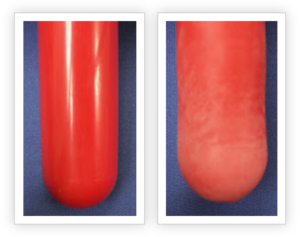Well, that depends… Certainly there are formulation differences among manufacturers that contribute to differences in nipple life. For example, each brand of calf nipple has a hardness characteristic that affects its performance. Put simply, the softer the nipple, the easier it is for newborn calves to suckle. The down side of softness is that it leads to shorter life. On the other hand, a hard nipple may last longer, but can be quite challenging for newborn calves. The material formulation used by each nipple manufacturer places their product somewhere along this spectrum, imparting characteristic ease-of-use and durability qualities.
Beyond basic formulation and manufacturing differences, there are other factors that have a big impact on nipple life. It is quite intriguing that even though two farms use the same brand of calf nipple, one farm manages an average life between 350 to 400 uses per nipple while the other achieves an average of over 600 uses. Both farms use the same product, and they even receive the same batch or manufacturing lot of the nipple. The possibility that this difference in life span is due to manufacturing issues is pretty remote.
Factors that cause wear

The picture on the right shows typical wear: swelling (more pronounced at the tip), thinning of the wall and elongation of the body of the nipple, loss of material strength.
Calf Nipples are subjected to two primary forces on the farm that cause them to wear. One is chemical, caused by cleaning and sanitizing solutions; the other is physical or mechanical resulting primarily from calves sucking and chewing on the nipples. To combat these forces and improve resistance to degradation, calf feeding nipples are typically made with natural rubber compounds. As mentioned earlier, each company has their unique formulation which affects nipple wear.
Mechanical effects on calf nipples
Rubber compounds help to reduce these effects, but the nursing activity of calves causes the wall of the nipple body to thin and elongate, eventually wearing out. The amount of time that a calf has access to the nipple after it has emptied the bottle can be a big component of life expectancy. Consider a situation where the farm allows calves to routinely suck and chew on nipples for two minutes after draining their bottles before they get around to collecting the bottles from the hutches. If the farm averages 450 uses per nipple, these innocent two minutes translate into 15 hours of idle sucking time on each nipple. That’s a rather sizable entertainment expense. A slight adjustment in management practices could go a long way toward improving nipple life on this operation.
Chemical effects on calf nipples
A wide variety of products and procedures are used to clean nipples — some good, some not so good. Many cleaning and sanitizing chemicals have a harsh effect on nipples. They remove the natural, protective oils from the rubber, causing it to dry out and become more susceptible to degradation. Even water itself causes rubber to swell, so immersion times in cleaning and sanitizing solutions should not go beyond the minimal time required for effective action. Remove nipples promptly and allow to air dry.
A recent laboratory evaluation took a look at the effects of various sanitizing/disinfecting solutions on calf nipple material. This study was concerned with the chemical effects of these solutions on swelling and material strength. The least damaging were chlorine products. The most damaging was iodine, with chlorhexidine products testing slightly better than iodine. Higher solution temperatures increased the damage. The results are certainly interesting and informative, but they do not mean that you should switch your sanitizing product. They do, however, indicate a relative potential for undesirable effects on calf nipple life. Good cleaning and sanitizing procedures can minimize these effects.
A word of caution ~
Sanitizing/disinfecting solutions need to be mixed according to label instructions. That list of organisms the product is effective against doesn’t describe watered-down solutions. Trying to cut costs or reduce harmful chemical effects by diluting sanitizing solutions is actually a waste of money.
______________________________
Odd, but True…

